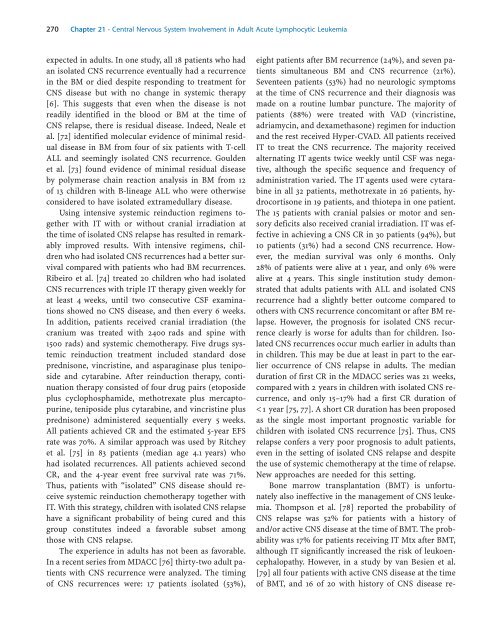Acute Leukemias - Republican Scientific Medical Library
Acute Leukemias - Republican Scientific Medical Library
Acute Leukemias - Republican Scientific Medical Library
You also want an ePaper? Increase the reach of your titles
YUMPU automatically turns print PDFs into web optimized ePapers that Google loves.
270 Chapter 21 · Central Nervous System Involvement in Adult <strong>Acute</strong> Lymphocytic Leukemia<br />
expected in adults. In one study, all 18 patients who had<br />
an isolated CNS recurrence eventually had a recurrence<br />
in the BM or died despite responding to treatment for<br />
CNS disease but with no change in systemic therapy<br />
[6]. This suggests that even when the disease is not<br />
readily identified in the blood or BM at the time of<br />
CNS relapse, there is residual disease. Indeed, Neale et<br />
al. [72] identified molecular evidence of minimal residual<br />
disease in BM from four of six patients with T-cell<br />
ALL and seemingly isolated CNS recurrence. Goulden<br />
et al. [73] found evidence of minimal residual disease<br />
by polymerase chain reaction analysis in BM from 12<br />
of 13 children with B-lineage ALL who were otherwise<br />
considered to have isolated extramedullary disease.<br />
Using intensive systemic reinduction regimens together<br />
with IT with or without cranial irradiation at<br />
the time of isolated CNS relapse has resulted in remarkably<br />
improved results. With intensive regimens, children<br />
who had isolated CNS recurrences had a better survival<br />
compared with patients who had BM recurrences.<br />
Ribeiro et al. [74] treated 20 children who had isolated<br />
CNS recurrences with triple IT therapy given weekly for<br />
at least 4 weeks, until two consecutive CSF examinations<br />
showed no CNS disease, and then every 6 weeks.<br />
In addition, patients received cranial irradiation (the<br />
cranium was treated with 2400 rads and spine with<br />
1500 rads) and systemic chemotherapy. Five drugs systemic<br />
reinduction treatment included standard dose<br />
prednisone, vincristine, and asparaginase plus teniposide<br />
and cytarabine. After reinduction therapy, continuation<br />
therapy consisted of four drug pairs (etoposide<br />
plus cyclophosphamide, methotrexate plus mercaptopurine,<br />
teniposide plus cytarabine, and vincristine plus<br />
prednisone) administered sequentially every 5 weeks.<br />
All patients achieved CR and the estimated 5-year EFS<br />
rate was 70%. A similar approach was used by Ritchey<br />
et al. [75] in 83 patients (median age 4.1 years) who<br />
had isolated recurrences. All patients achieved second<br />
CR, and the 4-year event free survival rate was 71%.<br />
Thus, patients with “isolated” CNS disease should receive<br />
systemic reinduction chemotherapy together with<br />
IT. With this strategy, children with isolated CNS relapse<br />
have a significant probability of being cured and this<br />
group constitutes indeed a favorable subset among<br />
those with CNS relapse.<br />
The experience in adults has not been as favorable.<br />
In a recent series from MDACC [76] thirty-two adult patients<br />
with CNS recurrence were analyzed. The timing<br />
of CNS recurrences were: 17 patients isolated (53%),<br />
eight patients after BM recurrence (24%), and seven patients<br />
simultaneous BM and CNS recurrence (21%).<br />
Seventeen patients (53%) had no neurologic symptoms<br />
at the time of CNS recurrence and their diagnosis was<br />
made on a routine lumbar puncture. The majority of<br />
patients (88%) were treated with VAD (vincristine,<br />
adriamycin, and dexamethasone) regimen for induction<br />
and the rest received Hyper-CVAD. All patients received<br />
IT to treat the CNS recurrence. The majority received<br />
alternating IT agents twice weekly until CSF was negative,<br />
although the specific sequence and frequency of<br />
administration varied. The IT agents used were cytarabine<br />
in all 32 patients, methotrexate in 26 patients, hydrocortisone<br />
in 19 patients, and thiotepa in one patient.<br />
The 15 patients with cranial palsies or motor and sensory<br />
deficits also received cranial irradiation. IT was effective<br />
in achieving a CNS CR in 30 patients (94%), but<br />
10 patients (31%) had a second CNS recurrence. However,<br />
the median survival was only 6 months. Only<br />
28% of patients were alive at 1 year, and only 6% were<br />
alive at 4 years. This single institution study demonstrated<br />
that adults patients with ALL and isolated CNS<br />
recurrence had a slightly better outcome compared to<br />
others with CNS recurrence concomitant or after BM relapse.<br />
However, the prognosis for isolated CNS recurrence<br />
clearly is worse for adults than for children. Isolated<br />
CNS recurrences occur much earlier in adults than<br />
in children. This may be due at least in part to the earlier<br />
occurrence of CNS relapse in adults. The median<br />
duration of first CR in the MDACC series was 21 weeks,<br />
compared with 2 years in children with isolated CNS recurrence,<br />
and only 15–17% had a first CR duration of<br />
< 1 year [75, 77]. A short CR duration has been proposed<br />
as the single most important prognostic variable for<br />
children with isolated CNS recurrence [75]. Thus, CNS<br />
relapse confers a very poor prognosis to adult patients,<br />
even in the setting of isolated CNS relapse and despite<br />
the use of systemic chemotherapy at the time of relapse.<br />
New approaches are needed for this setting.<br />
Bone marrow transplantation (BMT) is unfortunately<br />
also ineffective in the management of CNS leukemia.<br />
Thompson et al. [78] reported the probability of<br />
CNS relapse was 52% for patients with a history of<br />
and/or active CNS disease at the time of BMT. The probability<br />
was 17% for patients receiving IT Mtx after BMT,<br />
although IT significantly increased the risk of leukoencephalopathy.<br />
However, in a study by van Besien et al.<br />
[79] all four patients with active CNS disease at the time<br />
of BMT, and 16 of 20 with history of CNS disease re-
















